Sourdough Sandwich Bread
This post may contain affiliate links.
One of the recipes I get asked for the most is a soft sourdough sandwich bread made in a loaf pan. After trialling many inclusions and getting my family to vote on the best one, this easy recipe has become our family's go to soft sourdough sandwich loaf. Easy to bake and freeze, as well as the perfect toasting loaf, I'm sure you and your family will love it too!

Why You'll Love This Recipe!
Soft, Closed Crumb - A good sourdough sandwich bread needs to have a closed crumb (so the fillings don't fall out) and a light airy texture. I personally like a softer crust on my sandwich bread, but you can certainly make this sandwich loaf with a crustier crust.
It's So Forgiving - Unlike other sourdough bread where you have to be a little more gentle to preserve the bubbles and shape, this sourdough sandwich loaf is totally forgiving and needs no special treatment!
Makes Perfect Sandwiches - Always soft, never crumbly, this soft sourdough sandwich loaf makes the perfect sourdough sandwiches!

Ingredients
- Bread Flour - I prefer to make my sandwich loaves with protein rich bread flour rather than all purpose flour. If you're looking for a whole wheat flour alternative, I recommend this whole wheat sourdough sandwich bread.
- Sourdough Starter - You'll need active sourdough starter. I generally use 100g of starter in this loaf and don't have any issues bulk fermenting overnight, so long as the temperature isn't above 21ºC (69.8ºF). If you want to leave your sandwich loaf to bulk ferment overnight (and it's a bit warmer where you live), I recommend using just 50g of starter. You don't have to adjust anything else in the recipe. You can read about the effect of the starter amount on your sourdough.
- Water
- Butter & Sugar - To give this sourdough sandwich bread it's light, airy crumb I've added some butter and sugar. The butter and sugar help to give the bread a softer crust, perfect for a sandwich loaf. You can use the same weight in olive oil or coconut oil as butter if you want to make the loaf dairy free. You can use maple syrup instead of sugar, or leave it out altogether if you wish, but this will change the flavor and texture of the loaf.
- Salt
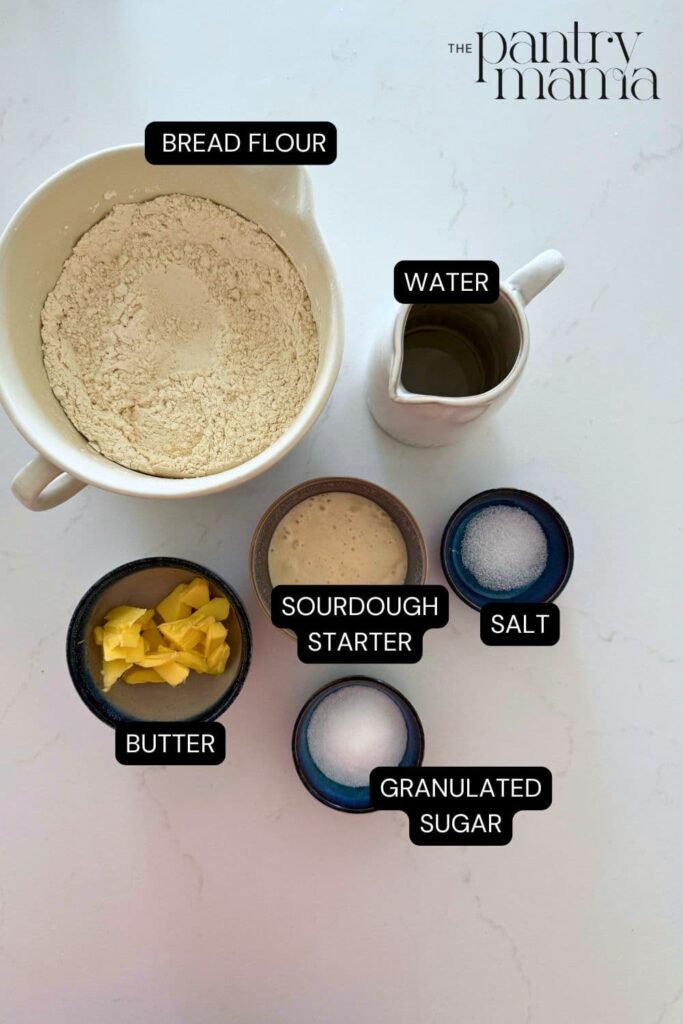
Equipment
Bread Pans - you'll need a selection of sandwich loaf pans to bake your bread. Having 2 or even 4 is a great idea if you want to bake several loaves at once. I love using USA pans and almost always bake this loaf in a USA Pan Pullman Pan (I do not use the lid) measuring 4"D x 4"W x 9"H or USA Pan 1.5 Pound Loaf Pan measuring 5"D x 10"W x 3"H.
Plastic Bread Bags - these are a great way to store your bread and fantastic if you're making multiple loaves at once. I do freeze my bread in these if I'm not freezing it for long, but if you are going to freeze your sourdough sandwich loaves for a few months, I recommend using freezer safe Ziplock bags.
Bread Slicing Guide - these are super handy if you're wanting perfectly sliced sandwich bread, although just having a great bread knife can be just as important to get even slices.

Overview: How To Make Sourdough Sandwich Bread
This sourdough sandwich bread recipe is written for a stand mixer (or Thermomix), which makes the process so much easier and saves time—something I appreciate with three kids in the house! There’s no stretching and folding involved, just straightforward kneading, which is perfect if you’re short on time. That said, you can absolutely knead this dough by hand. It does take a bit more effort to work in the butter and sugar, but it’s completely doable. However you knead it, the dough should be silky and elastic by the end, with no stickiness since this is an enriched dough.
Sourdough sandwich bread is a little different from a traditional sourdough loaf. The crumb is tighter, the crust thinner, and it doesn’t require a cold ferment. Instead, it goes through a bulk ferment followed by a second rise after shaping, where the dough fills the loaf pan at room temperature. You can delay baking by placing the dough in the fridge once it has filled the pan, though I wouldn’t leave it more than 24 hours. For the best results, it’s usually better to bake it right away.
Shaping a sourdough sandwich loaf is wonderfully simple. Once your dough has finished its bulk ferment, tip it onto the counter with the smooth side down and the sticky side up. Ease it into a rough rectangle with the short edge facing you, then gently pop any large bubbles and press it out lightly with your fingertips. Roll the dough into a log, tucking the ends under neatly, and let it rest on your work surface for about 30 minutes. After resting, tighten the log slightly by pulling it against the counter to create surface tension, then place it seam side down into a buttered loaf pan. Unlike shaping a boule or batard, you don’t need to overthink this step. If the top isn’t perfectly tight, don’t worry—the loaf will still rise beautifully above the rim of the pan and taste absolutely delicious when it comes out of the oven.
You'll find step by step instructions in the recipe card at the end of this post, as well as a video.
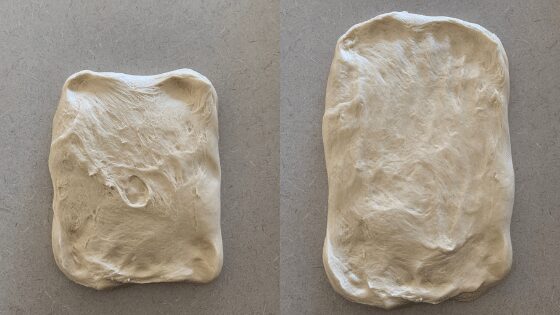

Baking Timeline
You can easily make this sourdough bread fit your schedule, it just needs a little tweaking. But since we are all about easy sourdough on any schedule here at The Pantry Mama, I've got your back! Here's the schedule I follow when making this sourdough sandwich loaf. A few things to note when thinking about tweaking this schedule:
- Bulk Fermentation - this is a low hydration loaf, as well as an enriched loaf, hence bulk fermentation and proofing will be fairly slow.
- Proofing - this loaf involves allowing the dough a second rise and you'll want to ensure the dough rises about the lip of the pan.
| TIME | PROCESS |
|---|---|
| 8:00 AM | Premix the dough and allow it to rest. |
| 8.30 AM | Add the salt, butter and sugar. |
| 9.30 AM | Knead the dough, resting when you need to. |
| 10.00 AM | Cover the dough, allowing it to bulk ferment. |
| 4.00 PM | Time to shape your sourdough sandwich loaf and place into your loaf pan. |
| 4.30 PM | Cover the pan and leave your loaf for the second rise. You want the dough to rise above the lip of the pan. |
| 9.00 PM | Bake your sourdough sandwich loaf. |
| 9.40 PM | Leave the loaf to cool on the counter overnight, ready for toast and sandwiches in the morning. |
Flavor Variations
While this recipe will never do you wrong, you can always add a few variations to make it a little more exciting! Try some of these:
- Hawaiian Loaf – Replace the water with pineapple juice for a delicious variation. It tastes quite similar to these sourdough Hawaiian rolls.
- Honey & Oat Sandwich Loaf – Add 20g of honey and 50g of oats to the mixture when you add the butter, sugar and salt. If you’d like to add oats to the top you should do so when you put the dough into the tin – spray the loaf lightly with water so the oats stick to the top.
- Multigrain Sandwich Loaf – Add 50 to 100g of your favorite seeds to the mixture when you add the butter, sugar and salt. Seeds like sesame, sunflower, pumpkin and flax work really well.
How to Store + Freeze
I make a lot of this sourdough sandwich bread! So here's how we store and freeze it in my home:
Store at Room Temperature - I use large ziplock bags or these plastic bread bags to store sliced loaves at room temperature. It lasts around 48 hours at room temperature once sliced. After that, it's suitable for toast.
Freezer - I store unsliced loaves in large ziplock bags for convenience. I tend to slice them once thawed.
Sandwiches - If you're a mama and you're making school lunches, this bread works so well! I even make a big batch of sandwiches and freeze them, making school mornings so much easier!
Things like ham and cheese, plain ham, peanut butter and jelly, honey or jam work the best when freezing. They defrost easily and you wouldn't even know they were frozen! To store frozen sandwiches, you can place each sandwich in a plastic ziplock bag. This makes them easy to place in lunchboxes in the morning.
Frequently Asked Questions
This dough is very slow to rise, so your dough may be rising, just a little more slowly than you're used to. It's not uncommon for this dough to take 12 hours for bulk fermentation. Make sure you keep the dough warm. One of the most common reasons for sourdough bread dough not to rise is that your sourdough starter is not active enough or not mature enough.
Gumminess is generally a sign that your sandwich loaf is under fermented. You'll generally see a line of under cooked dough at the base of the loaf to go along with the gummy crumb.
You can add inclusions to this recipe if you want to. I find the best time to add them is during the kneading of the dough.
This dough is very quick to knead with a stand mixer, but will take around 8-10 minutes to knead by hand.
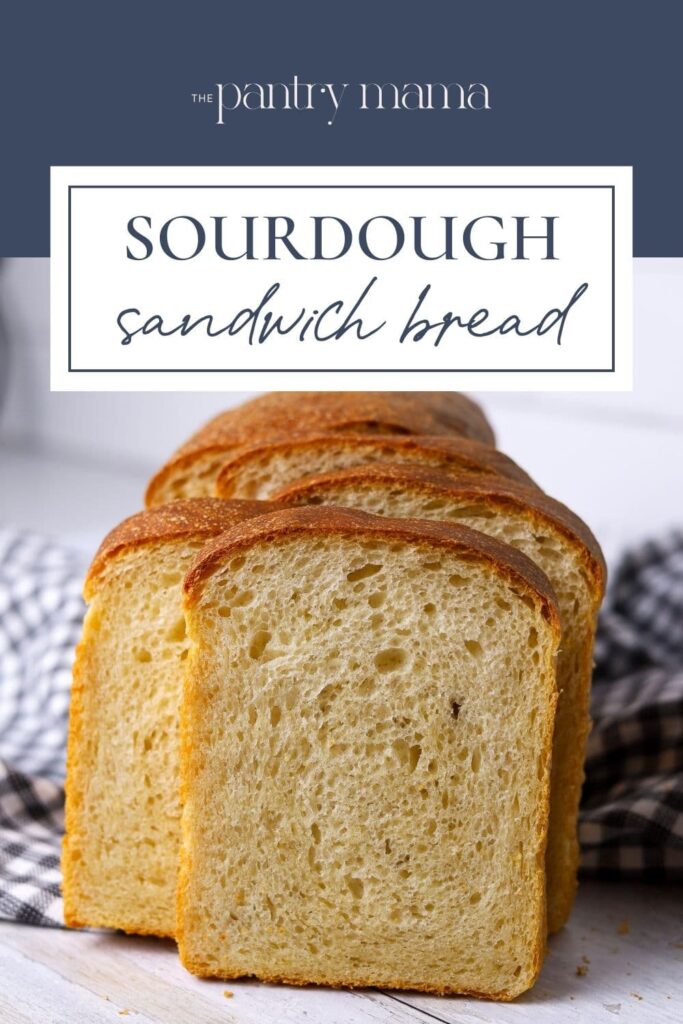
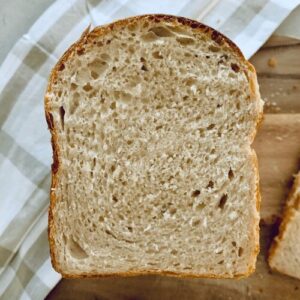
Sourdough Sandwich Bread Recipe
Video
Equipment
- Stand Mixer
- Loaf Pan (USA Pullman Pan 9" x 4" x 4" with no lid)
Ingredients
- 500 g Bread Flour
- 100 g Sourdough Starter (active, fed and bubbly)
- 280 g Water
- 60 g Butter (soft, cubed)
- 10 g Salt
- 20 g Granulated Sugar
Instructions
- Premix & Autolyse:Add your sourdough starter, flour and water into the bowl of your stand mixer.Knead the ingredients for around 30 seconds (using your dough hook) until they are just combined into a shaggy dough. Leave to autolyse for around 30 minutes.
- Now add the rest of your ingredients - salt, butter and sugar.Knead the ingredients for around 1 minute or until they are combined together. Now leave to rest for around 30 minutes.
- Kneading Your Sandwich Dough:Using the dough hook, knead the dough for around 3 minutes. The dough should become very elastic. You won't be able to see the butter as it will be well combined into the dough. Now give your dough a 30 minute rest.
- Now, knead your dough in the mixer for another 2-3 minutes. You'll know it's ready when it is slapping the sides of the bowl, it's soft and pliable and you can touch it without it sticking to your hands.If it's not quite there, it's ok to knead for a few more minutes to develop the gluten and get it to where it needs to be.
- Bulk Ferment:Once your dough is kneaded sufficiently, you need to bulk ferment it. At this point, you can just leave the dough as it is, covering it with some plastic wrap to stop it drying out. If you prefer your dough to be a bit neater, you can wet your hands and fold it into a neat ball.As with any sourdough bread, the bulk ferment time will depend on the temperature in your kitchen and of course the strength of your starter. You're looking for your dough to be just UNDER double.
- Shaping:Once your dough has finished its bulk ferment you can shape your dough. Before you start shaping, lightly butter your loaf pan.Ease your dough out of the bowl using a silicone dough scraper, remembering to have the smooth side on the counter and the sticky side facing up. You shouldn't need any flour for this as your dough shouldn't stick (it's such a beautiful silky, enriched dough).Gently ease your dough out into a rough rectangle, with the shortest side in front of you.Pop any large bubbles and gently flatten the dough using your fingertips. Then roll the dough up into a log (using the short side) and tuck the ends under. Leave the dough to sit and relax for around 30 minutes. After 30 minutes, tighten up the log by pulling the dough a little, using the sticky underside to create tension. Then simply plop the log into your buttered pan.
- Second Rise:Once your bread has been shaped and is in the tin, you'll need to let it rise again so that it fills up the shape of the pan. This should only take a few hours, but like the bulk ferment, this will depend on the strength of your starter and the temperature of your kitchen. You'll know it's done when it's risen above the lip of the pan (if you're using an open pan). It will be rounded on the top. When you poke it it will leave a slight indent but spring back nice and slowly. If you shaped it quite tight, you'll see some tension on the top of the dough as it's risen.
- Baking Your Sandwich Bread:Preheat your oven to around 180C/350F. Bake your sourdough sandwich loaf for approximately 40 minutes or until the top is golden brown. It may take a little longer depending on your oven. Once the loaf is baked, carefully place it on a rack to cool. Try to leave it at least one hour before you slice into it.
Notes
Nutrition



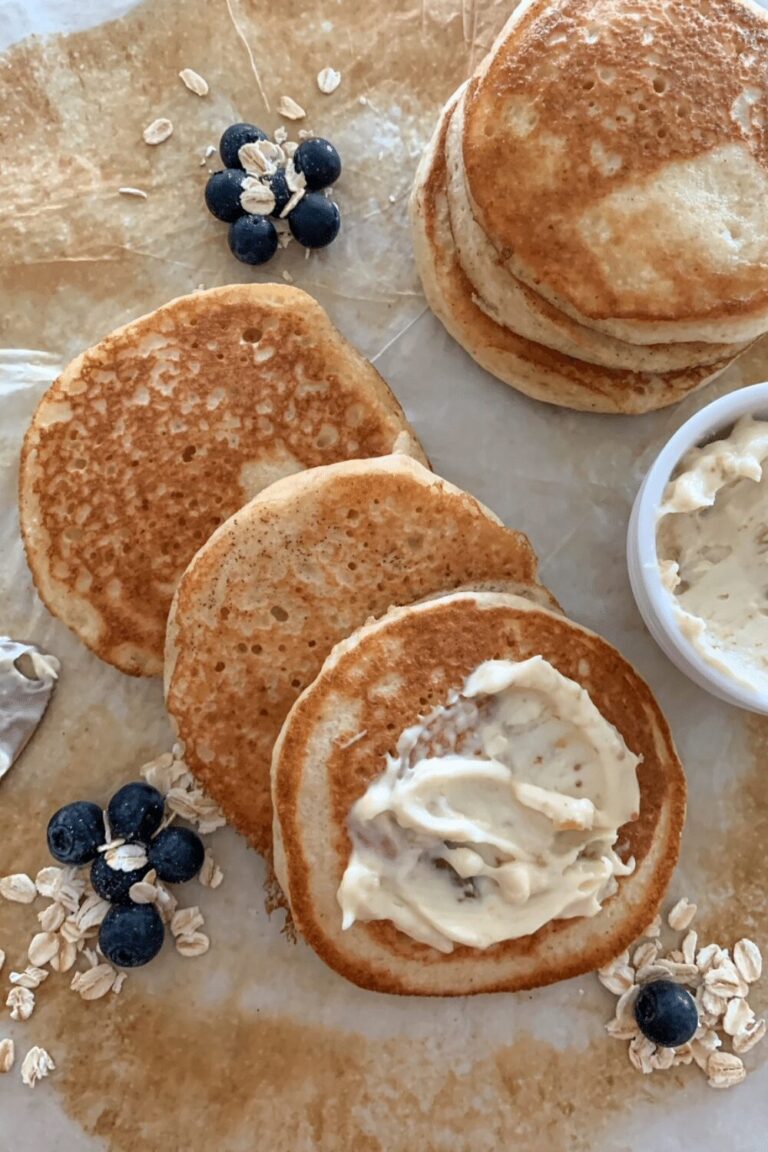
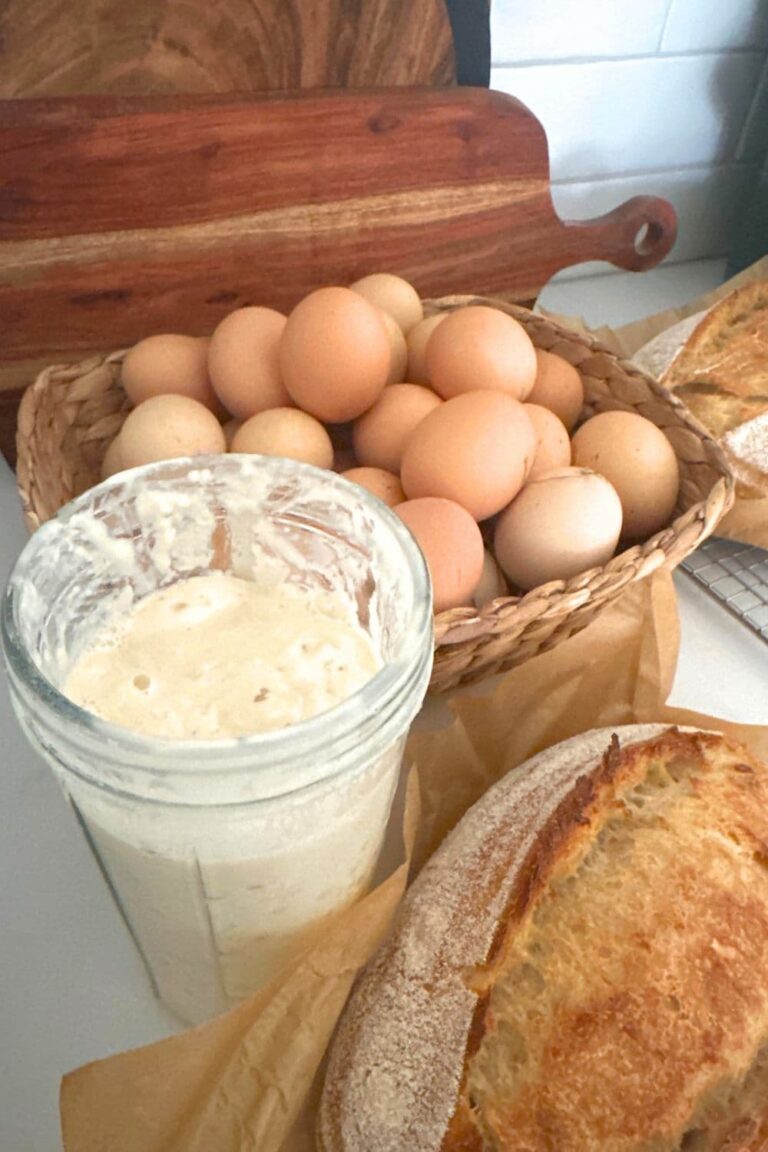


If substituting honey for the sugar. How much honey should I substitute for the sugar? Let's say for the 40g sugar = ___ g honey? And for the Thanks in advance!
Can I use milk instead of water (leaving out the sugar and powdered milk)?
what kind of flour can i use if i dont bread four? and can i use honey for sugar?
Can I use milk instead of water and leave out the sugar and milk powder?
If I wanted to make this a molasses and raisin loaf how much molasses do you think I’d need?
Hi, could you give some typical timings of what part of the day to start making the loaf please
Are we talking cold butter or room temperature/softened butter?
Would the 1 loaf recipe fill the new 1kg Pullman Bread Pan I just bought or do I need to double the recipe. Thank you. Excited to try this.
I am new to sourdough baking and so far, this recipe is the closest I have come to my grandmother's recipe. She passed away in 2005 and it will always be one of the great regrets of my life that I did not get her recipe before she passed. The sourdough she made was always in a loaf pan like this with a thin crust, however her crumb was looser. Any tips on how to not get the crumb so tight? I know that defeats the purpose of a sandwich bread but I'd like to try to get as close to her recipe as possible. Thanks again! Love your site!
I've made this bread twice now, and it has come out SO sticky both times. I am using everything (weighed) except the milk powder. I wonder if this is because it is hot and humid right now? Definitely not "silky and smooth".
Also, I thought I had read through the recipe, but was surprised to find that the prep time is actually 90+ minutes (3 instances of 30 minute "rests"), and really 120+ minutes if you count the 30 minutes after rolling it into a log after the bulk ferment. I started wayyy too late the first time, thinking it was only going to be an hour. 🙂
Can I do my 2nd rise in the refrigerator over night?
Hi, if I don’t want to use milk powder, I don’t have to substitute with anything do I? I would just simply not use it correct?
That's correct 🙂
will this make a difference to the wetness of the dough?
Should the bulk ferment be @ room temperature or refrigerated?
Bulk ferment is always at room temperature 🙂
Can I use All purpose flour instead of bread flour?
My dough is insanely sticky after bulk ferment. House is about 73 degrees and it sat overnight for about 12 hours. I used 100g of starter. What did I do wrong? I used my kitchenaid for all.
Can I use whole wheat, or unbleached white flour or a mixture of both white and whole wheat instead of bread flour?
We live on a boat and it is too warm here, even with A/C, to bulk ferment overnight. Roughly, how long will it take for bulk fermentation say at roughly 82F? And if time runs out, I know you say you can put it in the fridge, but is that after the second rising or before? Could I put it in the fridge before and then take it out and let it rise on the counter the next day? TIA.
Do you cover it with plastic wrap for the second rise?
What is the purpose of the powdered milk and how is the loaf different if it is left out? Thank you!
Looks great! If I start this first thing in the morning, would I be baking it in the evening depending on temperature of my kitchen? Thanks!
I love this recipe, however I really struggle with planning my day around the mix/knead and rest for 30 minute part. Would it be possible to do all the mining kneading after the initial autolyse? So starter/water/flour then autolyse, then remaining ingredients immediately mix and knead, then bulk?
I’m just waiting for my dough to bulk ferment. I’ve found out my trusty loaf pan and it measures the same size as yours but it’s only 2 1/2 inches deep. Should I use 2 based on your recipe please ?
First time making a sourdough sandwich bread I was hesitant however decided to bite the bullet and it is amazing - I used King Arthur Bread flour and did the honey oat option yummm
the dough was very hard and my 30 year old kenwood was slapping it around like a ball
went through all motions but mostly kneaded manually
i also had to add 15 minutes to bake time more close to an hour as the top wouldn’t get color and interior temp did not go up to 200 ( maybe this is normal since it is baking at 350 not 500 like the DO bread )
It tastes so good it does not need the works of a sandwich lol thank you for sharing recipes
I made this last night, cut today, and man alive, is it good! I normally regard a recipe as a general "suggestion," but usually follow bread recipes to the letter. I **almost** did that here. I added 1 tablespoon of gluten flour and split flour into 300g whole wheat + 200g bread flour. Great & wonderful stuff!
I made this for the 3rd time today and it's wonderfully incredible! I favor whole wheat bread and used about 1/2 and 1/2 white to whole wheat flour the first 2 times. Today I had only 154 g bread flour left in the canister and so I used 346 g whole wheat flour (King Arthur in the US), plus added 2 tablespoons Azure vital wheat gluten to the mix. I also used an extra 20g starter and reduced water by the same amount. Man alive, is this bread amazingly good!!!!!! I believe I'll keep the bread/whole wheat flour at today's ratio plus add another tablespoon of gluten flour to the mix next time.
What I want is a fine-textured whole wheat bread that will fit into the toaster if I want it to, with a crumb that's fine enough not to let mayo or mustard squish through "holes." I also want a soft crust. This recipe delivers it ALL! THANK YOU for this great & wonderful recipe!
Wonderful recipe. Never buying store bought bread again. Question….2nd rise in the loaf pan, can it be done in the frig over night?
Can I substitute honey for sugar? If so how much?
My second rise-didn’t rise. 😟 what did I do wrong? Lol.
If I were to add inclusions to make cheddar garlic or cheddar jalapeño loaf, would I add those ingredients during the initial shaping? After the bulk ferment when the dough is spread out? And do you think would this affect the rise any? BTW, Loving your recipes!! 🙂
Someone in a sourdough group I'm in recommended your sandwich loaf recipe. Still working with my starters, so it will be a little while before I bake. Will definitely give this a go. I just have one question. I have a cast iron loaf pan and was wondering what adjustments I might need to make for baking. Thank you so much for sharing your talents with people wanting to learn!
What’s the benefit of using powdered milk? Would substituting regular milk for the same amount of water give it the same effect?
Thank you for all your tips! I love your recipes!😊
Does cubed butter actually disperse evenly throughout the loaf? Help me understand why you use cubed butter instead of softened butter or melted butter. TIA. Looking forward to trying your recipe.